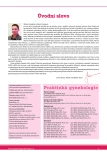Mammographic density and the incidence of breast cancer – our experience
Authors:
V. Bella; L. Bellová
Authors‘ workplace:
Onkologický ústav sv. Alžbety v Bratislave
Published in:
Prakt Gyn 2011; 15(1): 11-14
Category:
Original Article
Overview
Introduction:
Carcinoma of the breast is the most frequently occurring malignant tumour amongst the female population. The etiology of the origins of this disease is multifactorial. Several risk factors, related to carcinoma of the breast, are known from epidemiological studies. High-risk factors also include the density of the mammary gland.
It was the aim of our study to ascertain the extent to which density of the mammary gland has an effect on the origins of carcinoma of the breast.
Materials and methods:
In our retrospective study, we ascertained the correlation between increased mammographic density and the incidence of carcinoma of the breast in 691 women with carcinoma of the breast and 1,382 women without carcinoma of the breast, aged 40–74 years, at 5-year age intervals.
Methods:
Three doctors made an independent, subjective assessment of mammary gland density, resulting in an average density from the three results gained.
Results:
A positive correlation was found at all age intervals. The results had high statistical significance in women, regardless of their age.
Conclusion:
The density of the mammary gland is a risk factor in incidence of carcinoma of the breast.
Key words:
breast cancer – density of breast – risk of breast cancer
Sources
1. Bella V. Rizikové faktory karcinómu prsníka. In: Bella V et al (eds). Karcinóm prsníka. Banská Bystrica: Advert 2005 : 21–28.
2. Boyd NF, Guo H, Martin LJ et al. Mammographic density and the risk and detection of breast cancer. N Engl J Med 2007; 356(3): 227–236.
3. Boyd NF, Lockwood GA, Martin LJ et al. Mammographic densities and risk of breast cancer among subjects with a family history of this disease. J Natl Cancer Inst 1999; 91(16): 1404–1408.
4. Byrne C, Schairer C, Brinton LA et al. Effects of mammographic density and benign breast disease on breast cancer risk (United States). Cancer Causes Control 2001; 12(2): 103–110.
5. Chiarelli AM, Kirsh VA, Klar NS et al. Influence of patterns of hormone replacement therapy use and mammographic density on breast cancer detection. Cancer Epidemiol Biomarkers Prev 2006; 15(10): 1856–1862.
6. Ghosh K, Vachon CM. Mammographic breast density, endocrine therapies, and breast cancer risk. Menopausal Med 2010; 18(1): 34–40.
7. Habel LA, Capra AM, Achacoso NS et al. Mammograhic density and risk of second breast cancer after ductal carcinoma in situ. Cancer Epidemiol Biomarkers Prev 2010; 19(10): 2488–2495.
8. Martin LJ, Boyd NF. Mammographic density potential mechanisms of breast cancer risk associated with mammographic density. Hypothesis based on epidemiological evidence. Breast Cancer Res 2008; 10(1): 201.
9. Tlsty T. Breast Cancer Risk Associated with High Mammographic Density. Grant in University of California 2005. Available from: http://www.cbcrp.org/research/PageGrant.asp?grant_id=3976.
10. Vacek PM, Geller BM. A prospective study of breast cancer risk using routine mammograpic breast density measurements. Cancer Epidemiol Biomarkers Prev 2004; 13(5): 715–722.
11. Vachon CM, Kuni CC, Anderson K et al. Association of mammographically defined percent breast density with epidemiologic risk factors for breast cancer (United States). Cancer Causes Control 2000; 11(7): 653–662.
12 .White J. Breast density and cancer risk: what is the relationship? J Natl Cancer Inst 2000; 92(6): 443.
Labels
Paediatric gynaecology Gynaecology and obstetrics Reproduction medicineArticle was published in
Practical Gynecology

2011 Issue 1
Most read in this issue
- Necrotic myoma in pregnancy
- The methods of skeletal age assessment
- Cryopreservation of cells and tissues in assisted reproduction
- Correlation between ultrasound, hysteroscopy and histological picture of endometrial polyps
